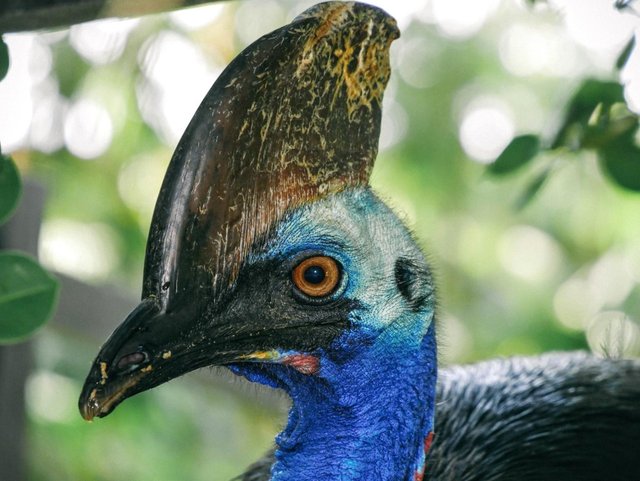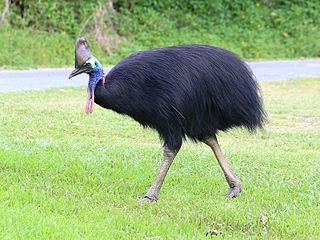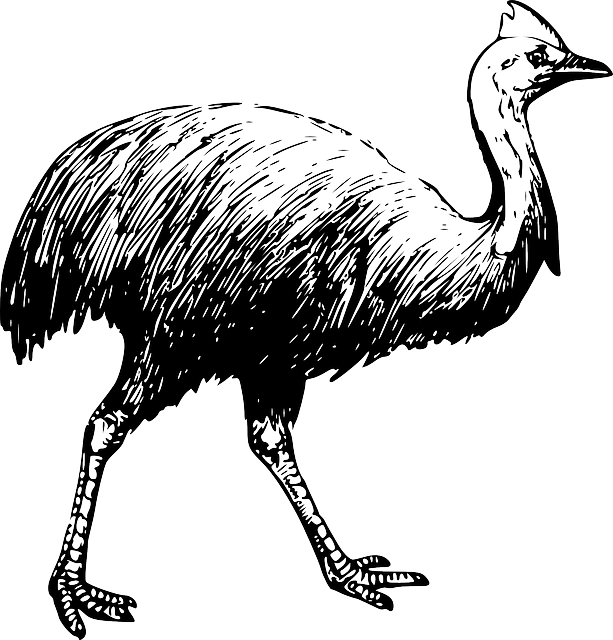Let's talk about the most dangerous bird on planet earth

A Cassowary. Source: Pixnio. Public domain ( CCO ) Licensed.
Cassowary is a very terrifying bird; which possesses long dagger-like claw on the inside of each foot. Although, so many humans have been severely injured by these birds, there is one recorded death case popularly known.
Two brothers Philip and Grandville Mclean, 16 and 13 years of age encountered this bird while they were trying to retrieve a stray horse from a land covered with bush. They went with their dog, and before they knew what was happening, their dog started attacking the bird. Grandville, the younger brother rushed in to save the dog and was viciously kicked by the cassowary, Philip then hit the bird with a stick, as a result, the bird started pursuing him and when he fell to the ground, the bird jumped on him, and cut his jugular(neck or throat). He managed to stand up and tried to run, but he couldn't, he collapsed almost immediately and bled to death.
This very unfortunate story and many more stories of deep cuts that this dangerous bird inflicts on people is the reason why Cassowary is called the most dangerous bird in the world.
The name Cassowary was derived from the papuan word Kasu-weri, which means horn head. And obviously, we can see the strong looking horn in the picture above. Hence, it's no surprise that the name of this animal means horn head. Cassowaries are ratites, which means flightless birds without a keel (an extension of the breastbone). The keel is the part of the bird that provides support for the wing's muscles to attach, hence providing a good enough leverage for flight.
Scientific classification. Kingdom: Animalia. Phylum: Chordata. Class: Aves. Order: Casuariiformes. Family: Casuariidae. Kaup, 1847[1]. Genus: Casuarius. Brisson, 1760. Type species. Struthio casuarius. Linnaeus, 1758
Species: Casuarius casuarius- Southern cassowary, Casuarius unappendiculatus- Northern cassowary, Casuarius bennetti- Dwarf cassowary, †Casuarius lydekkeri- Pygmy cassowary Source
As you can see above from the scientific classification, there are four species of Cassowary; three of which are extant species(meaning that they are still in existence or they are not extinct or lost or destroyed). Of the four species, the Southern Cassowary is the most common, it is the second heaviest bird in the world, only Ostrich and Emu are bigger. Basically, they feed on fruits, although some species are omnivorous (feeding on both plants and animals), thus they can eat so many different foods, including grass seeds and shoots, invertebrates and also they can eat small sizes vertebrates(organisms with backbones). When Cassowaries are provoked, they are capable of inflicting injuries, which could be fatal.
Casuarius iydekkeri, also known as Pygmy Cassowary, is the only species of the four species of Cassowary that is extinct (lost or destroyed). Before they went extinct, they were usually found in New South Wales and Papuan New Guinea. Usually, all Cassowaries are shy birds that are found in the deep forest, they are known to disappear whenever they sense that humans are coming close. Southern Cassowary are usually found in rain forests, specifically the Queensland forests. It has been found that the females are bigger than the males and are more brightly colored.
Usually, the adult male Southern Cassowaries are 4.9-5.9 ft tall, while the females are about 6.6 ft tall (Guys, did you read that!, some of these birds are as tall as basketball players). i am about 6 ft tall and honestly I'm imagining a dangerous bird that is taller than myself; it's not a funny imagination at all (6.6 ft, what??). They all have feathers that usually consist of loose barbules and shafts. They lack retrices (meaning tail feathers).
In year 2007, the Guiness World Records listed Cassowary as the most dangerous bird in the world. These birds have three toes with sharp claws on each feet. The second toe has a dagger like claw that can rupture the belly of an animal, cause severe deep cut, in fact, cut off the arm of animals. Cassowaries have powerful legs, that they use to kick animals and humans (karate bird, smiles!!). Guess what?, they are also very fast, would you believe that Cassowaries can run up to 50 Km/h. They can jump as high as 4.9 ft to deliver a kick (What??). Imagine!!, they can also swim. These dangerous birds can swim across wide rivers and even swim in the sea (Now, that's marveling!!)
Casque
The three extant species have a keratinous skin cover called Casque on their heads. The Southern Cassowaries have been found to have the largest casque of the three species. I'm sure that you've been looking at the pictures, and you've been wondering what kind of strong heads these birds have?. In fact, if these birds decide to head somebody, it could be very catastrophic (smiles!!); although we've never heard of any heading from these creatures, I'm just imagining! (Lol).
Some researchers have been suggesting that these Casque have a function or role that they play. Let me share some of their suggestions with us- some researchers claim that it represents secondary sexual characteristics (which are signs of puberty and sexual maturity in animals). If that's the reason for these heavy skulls, then it's really funny, because how can a bird carry such a heavy load on its head just to show that it 's sexually mature(smiles!!!), that's something else.
One theory is that casque help the animals push aside forest underbrush. The structures might also be used as a way to attract the opposite sex.Source
Some other researchers suggested that the Casque are used as weapon during their fights to show dominance over each other. Some said that it is used to push aside leaves during foraging (search for foods).
Some other researchers also suggested that Cassowaries lower their heads when they are running through vegetation, and that these Casque would serve as protection for the skull from any form of collision. Other researchers speculate that Cassowaries may use these Casque for either acoustic communication or sound reception. It has also been found that wild Cassowaries have an average life span of about 40-50 years, while in captivity, some Cassowaries live up to 61 years (Wow!!, that's quite long, 61 years for a bird!!).
Cassowaries are usually found in humid rain forests in New Guinea and also, they are found in smaller islands, as well as in the Northeastern Australia. Although, researchers are not really sure whether or not some Cassowaries found in some islands are natural or they arrived there as a result of the trading of young Cassowaries by the people of those regions.
Solitary Birds
Usually, Cassowaries are lone birds (meaning that they don't live in groups), except during egg-laying, courtship and sometimes when they are around plenty food supplies. The males defend their territory, while the females overlap territories of many males- the females mate several males. The females do not go too far, as a result, all through their life span, they keep on mating the same set of males or closely related males. The male and female may copulate (have sex or mate) for long period of time. Sometimes, another male may come close to the mating Cassowaries and push the first male off (hahaha oppression!). He would then climb on the female Cassowary and copulate as well.
These birds start to breed in May to June. The females usually lay between three to eight eggs. The eggs are naturally pale green blue or bright green in color. The size of the egg is about 9 by 14cm (Wow! if you have a ruler with you there, take a look at 14cm, that's really long!).
These eggs are really large, only the eggs of Emu and Ostrich are larger. Unlike with most animals where the females incubate the eggs (meaning grow the eggs under favorable conditions), in the case of Cassowaries, it's the males that incubate the eggs for about 50 to 52 days. The males protect the young chicks, that stay in the nest for there about 9 months, fiercely defending the chicks against all forms of predators, including man. When the chicks are matured enough, the young males then go out to find a territory for themselves.
The male also teaches his growing birds how to forage so that when he eventually chases them away, the youngsters can fend for themselves.source
Surprisingly, the female Cassowaries do not show any little concern for the eggs or the chicks, rather they move on to copulate with another male, lay eggs in the nests and move on yet again. The young Cassowaries are brown in color, with buffy stripes.
As I mentioned above, these animals eat fruits mainly, hence they are usually seen under trees that have fallen fruits. They defend a particular tree from other Cassowaries for some days, until the fruits are depleted (greedy guys right?). Guess what?, they swallow a whole fruit (wow!!), I mean, they don't attempt to bite, or eat it gradually, they swallow the whole fruit e.g apples, these guys swallow a full apple!!!, bananas too and so many other fruits.
Cassowaries have been found to be really helpful in the distribution of seeds across the forest floors through excrements. According to Australian Administrative officers, eating Cassowary is unadvisable, because the meat and bone are very tough, very strong. And there's a saying they make; when cooking a Cassowary, put a stone in the pot, when the stone is cooked, then the Cassowary is ready (hahaha, one can only imagine how tough Cassowary would be, for it to be compared with a stone!).
In Queensland, Australia, Southern Cassowary is endangered. Research has it that only about 20-25% of the former Cassowary habitat remains. It was stated that the primary cause of the death of Cassowaries in that region was habitat loss. Also research has it that a large number of Cassowaries are killed by vehicles. This is because Cassowaries enter the roads, and think that the road is part of their forest. So they just chill at the center of the road, and before they know what's happening, they've been stroke down by a vehicle. It was as a result of hand feeding that these birds were lured into suburban regions; which is the biggest threat to their lives. Since by coming into suburban regions or areas, they are more exposed to car accidents.
Attacks
It has been found that Cassowary attacks against humans have been mostly due to people feeding these dangerous birds. Some cases involved these birds just suddenly chasing or charging their victims. And a few other cases involved them defending their eggs or chicks. Sometimes, Cassowary strikes the abdomen of animals, leading to rupturing (bursting open) of the intestine.
If for any reason you provoke these birds, your best defense is to find a shield or any strong material that you can use to protect yourself from the dagger like claw, or go behind a tree, and as it chases you, you go round and round the tree until the Cassowary is exhausted and leaves. Please, do well to steer clear of these dangerous birds.
)
)
)
.jpg](https://cdn.steemitimages.com/DQmSVBmRy3RNHKrdSTzTotDJa52NGXgGb8ktziLZGpoTzok/Double-wattled_Cassowary_or_Kasuari_(Casuarius_casuarius).jpg))

I've always though ostriches as the most dangerous birds in the world. I guess it got a competitor.
O yes! @conficker, the Ostrich sure has Cassowary as a competitor. Thanks for reading!!
Damn!!! That first image is very scary.
I haven't heard of this creature before, above 6 ft that's really tall. 61 years is quite massive. Australia the home to dangerous creatures (smiles)
Great article @starrichie
Thanks for coming around @menoski. These birds are tall indeed.
Hi @starrichie!
Your post was upvoted by utopian.io in cooperation with steemstem - supporting knowledge, innovation and technological advancement on the Steem Blockchain.
Contribute to Open Source with utopian.io
Learn how to contribute on our website and join the new open source economy.
Want to chat? Join the Utopian Community on Discord https://discord.gg/h52nFrV